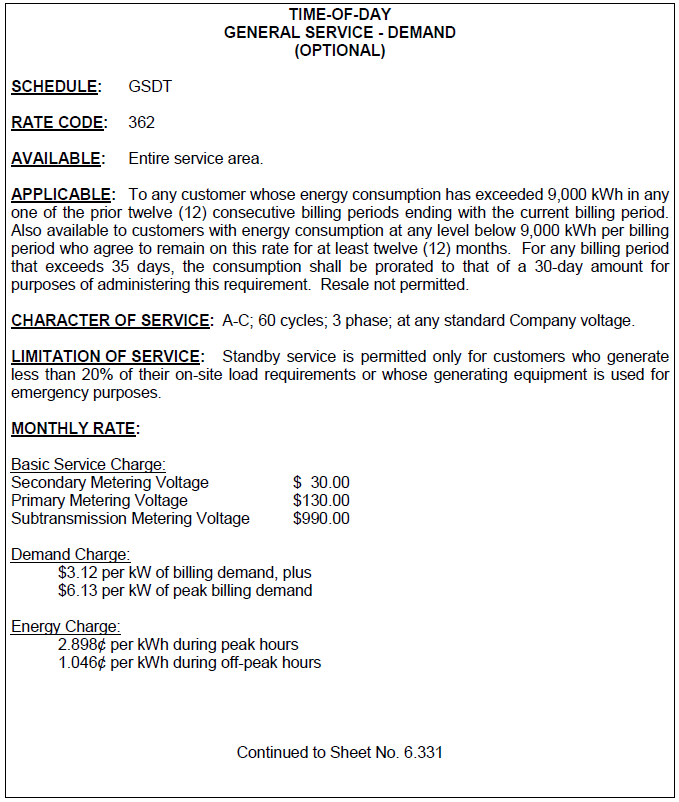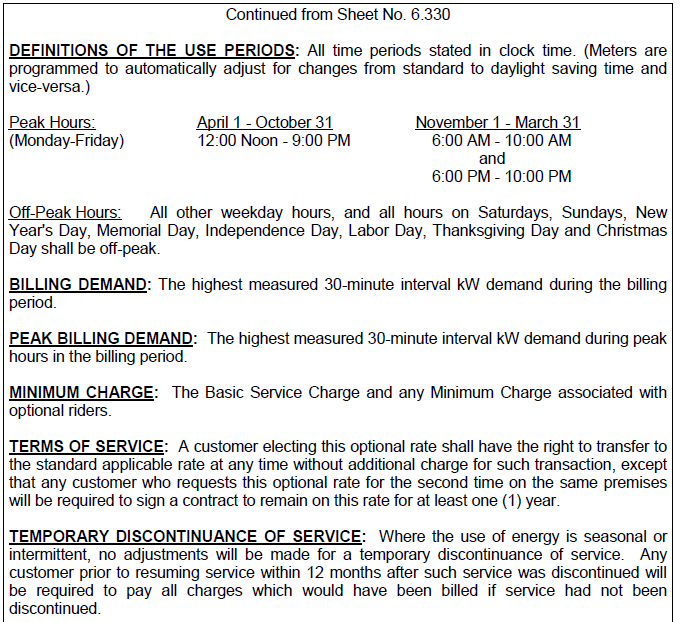As the rates for peak and off-peak are same for summer and winter, I think the season would be annual instead of summer of winter. The Total tariff structure could be:
!- =========== ALL OBJECTS IN CLASS: UTILITYCOST:TARIFF ===========
UtilityCost:Tariff,
Tampa_GSDT_ToD, !- Name
Electricity:Facility, !- Output Meter Name
kWh, !- Conversion Factor Choice
, !- Energy Conversion Factor
, !- Demand Conversion Factor
TimeOfDaySchedule, !- Time of Use Period Schedule Name
TwoSeasonSchedule, !- Season Schedule Name
, !- Month Schedule Name
HalfHour, !- Demand Window Length
30, !- Monthly Charge or Variable Name
, !- Minimum Monthly Charge or Variable Name
, !- Real Time Pricing Charge Schedule Name
, !- Customer Baseline Load Schedule Name
, !- Group Name
BuyFromUtility; !- Buy Or Sell
!- =========== ALL OBJECTS IN CLASS: UTILITYCOST:CHARGE:SIMPLE ===========
UtilityCost:Charge:Simple,
Peak_energy, !- Name
Tampa_GSDT_ToD, !- Tariff Name
peakEnergy, !- Source Variable
Annual, !- Season
EnergyCharges, !- Category Variable Name
0.02898; !- Cost per Unit Value or Variable Name
UtilityCost:Charge:Simple,
Off-Peak_energy, !- Name
Tampa_GSDT_ToD, !- Tariff Name
offPeakEnergy, !- Source Variable
Annual, !- Season
EnergyCharges, !- Category Variable Name
0.01046; !- Cost per Unit Value or Variable Name
UtilityCost:Charge:Simple,
PeakBillingDemand, !- Name
Tampa_GSDT_ToD, !- Tariff Name
peakDemand, !- Source Variable
Annual, !- Season
DemandCharges, !- Category Variable Name
6.13; !- Cost per Unit Value or Variable Name
UtilityCost:Charge:Simple,
BillingDemand, !- Name
Tampa_GSDT_ToD, !- Tariff Name
totalDemand, !- Source Variable
Annual, !- Season
DemandCharges, !- Category Variable Name
3.12; !- Cost per Unit Value or Variable Name
UtilityCost:Charge:Simple,
FuelCostAdjustEnergyCharge, !- Name
Tampa_GSDT_ToD, !- Tariff Name
peakEnergy, !- Source Variable
Annual, !- Season
EnergyCharges, !- Category Variable Name
0.03937; !- Cost per Unit Value or Variable Name
UtilityCost:Charge:Simple,
FuelCostAdjustEnergyCharge, !- Name
Tampa_GSDT_ToD, !- Tariff Name
offpeakEnergy, !- Source Variable
Annual, !- Season
EnergyCharges, !- Category Variable Name
0.03564; !- Cost per Unit Value or Variable Name
UtilityCost:Charge:Simple,
EnergyConservCharge, !- Name
Tampa_GSDT_ToD, !- Tariff Name
totalEnergy, !- Source Variable
Annual, !- Season
DemandCharges, !- Category Variable Name
0.65; !- Cost per Unit Value or Variable Name
UtilityCost:Charge:Simple,
CapacityCharge, !- Name
Tampa_GSDT_ToD, !- Tariff Name
totalDemand, !- Source Variable
Annual, !- Season
DemandCharges, !- Category Variable Name
0.53; !- Cost per Unit Value or Variable Name
UtilityCost:Charge:Simple,
EnvironCharge, !- Name
Tampa_GSDT_ToD, !- Tariff Name
totalEnergy, !- Source Variable
Annual, !- Season
EnergyCharges, !- Category Variable Name
0.00429; !- Cost per Unit Value or Variable Name
UtilityCost:Charge:Simple,
TaxofeightPercent, !- Name
Tampa_GSDT_ToD, !- Tariff Name
SubTotal, !- Source Variable
Annual, !- Season
Taxes, !- Category Variable Name
0.025641; !- Cost per Unit Value or Variable Name
Let me know if I have missed something? The week schedule will be defined for weekdays with peak=1 and offpeak=3 followed by Weekends and Holidays =3.








Complex Tariff Modeling section is also not suitable for finding the demand charges as its dependent on finding the max demand for a 30-minute interval for billing and peak billing times.
To get a 30-minute interval for kW demand, use the UtilityCost:Tariff field called Demand Window Length and set it to HalfHour. Why are you saying that is not suitable?
I want to use these http://tampaelectric.com/files/tariff... Time of day rates (GSDT rate). And demand windows will be applicable for all the demand. The demand is to part one for base billing and PLUS demand for peak billing demand (which i think would need to be calculated for peak windows only). Any suggestions of implementing this?